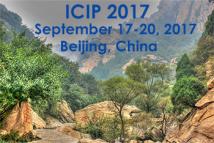
The International Conference on Image Processing (ICIP), sponsored by the IEEE Signal Processing Society, is the premier forum for the presentation of technological advances and research results in the fields of theoretical, experimental, and applied image and video processing. ICIP has been held annually since 1994, brings together leading engineers and scientists in image and video processing from around the world. Visit website.
- Read more about View synthesis with hierarchical clustering based occlusion filling
- Log in to post comments
- Categories:
 10 Views
10 Views- Categories:
 15 Views
15 Views- Read more about LEARNING DISCRIMINANT GRASSMANN KERNELS FOR IMAGE-SET CLASSIFICATION
- Log in to post comments
Image-set classification has recently generated great popularity due to widespread application to challenging tasks in computer vision. The great challenges arise from measuring the similarity between image sets which usually exhibit huge inter-class ambiguity and intra-class variation. In this paper, based on the assumption that each image set as a linear subspace can be treated as a point on a Grassmann manifold, we propose discriminant Grassmann kernels (DGK) of principal angles between subspaces.
2516_ppt.pdf
- Categories:
 21 Views
21 Views- Read more about EXTRACTING KEY FRAMES FROM FIRST-PERSON VIDEOS IN THE COMMON SPACE OF MULTIPLE SENSORS
- Log in to post comments
Selecting authentic scenes about activities of daily living (ADL) is useful to support our memory of everyday life. Key-frame extraction for first-person vision (FPV) videos is a core technology to realize such memory assistant. However, most existing key-frame extraction methods have mainly focused on stable scenes not related to ADL and only used visual signals of the image sequence even though the activities usually associate with our visual experience. To deal with dynamically changing scenes of FPV about daily activities, integrating motion and visual signals are essential.
- Categories:
 4 Views
4 Views- Read more about A METHOD OF RESIZING IMAGES BY CONTENT PERCEPTION
- Log in to post comments
With the popularity of mobile devices having smaller screens, it is important to focus on the clarity of the displayed content for the end users. Currently, there is no link between the layout or size of displayed image and the information content in those images. In this paper, we present a method for optimally arranging and displaying a group of images, where the relative size of the images is proportional to the number of objects in the images, or the number of faces.
- Categories:
 11 Views
11 Views- Read more about CHAM: ACTION RECOGNITION USING CONVOLUTIONAL HIERARCHICAL ATTENTION MODEL
- Log in to post comments
(1)We improved the soft attention model by introducing convolutional
operations inside the LSTM cell and attention map generation process to capture the spatial layout.
(2)We built a hierarchical two layer LSTM model for action recognition. (3)We tested our model on
three widely applied datasets, the UCF sports dataset, the Olympic dataset and the HMDB51 dataset
with improved results on other published work.
poster.pdf
- Categories:
 19 Views
19 Views3D immersive communications are trending as real-time point
clouds capture and display of point cloud video become feasible.
This paper presents a novel motion-compensated approach to encoding
dynamic voxelized point clouds (VPC) at low bit rates. A simple
coder breaks the VPC into blocks which are intra-frame coded or
replaced by a motion-compensated version of a block in the previous
frame. The decision is optimized in a rate-distortion sense, encoding
with distortion both geometry and the color, at reduced bit-rates. Inloop
- Categories:
 27 Views
27 Views- Read more about CONTEXT-BASED OCTREE CODING FOR POINT-CLOUD VIDEO presentation
- Log in to post comments
3D and free-viewpoint video has been moving towards solid-scene representation using meshes and point clouds. Pointcloud processing requires much less computation and the points in the cloud are minimally represented by their geometry (3D position) and color. A common point-cloud geometry compression method is the octree representation, which acts on individual frames. We present a lossless inter-frame compression method for pointcloud geometry, by reordering each octree based on previous frames prior to entropy coding.
- Categories:
 20 Views
20 Views- Read more about NONLINEAR SUBSPACE CLUSTERING
- Log in to post comments
This paper presents a nonlinear subspace clustering (NSC) method for image clustering. Unlike most existing subspace clustering methods which only exploit the linear relationship of samples to learn the affine matrix, our NSC reveals the multi-cluster nonlinear structure of samples via a nonlinear neural network. While kernel-based clustering methods can also address the nonlinear issue of samples, this type of methods suffers from the scalability issue.
- Categories:
 26 Views
26 Views- Read more about Light-field image compression based on variational disparity estimation and motion-compensated wavelet decomposition
- Log in to post comments
This paper presents a compression framework for light-field images. The main idea of our approach is exploiting the similarity across sub-aperture images extracted from light-field data to improve encoding performance. For this purpose we propose a variational optimisation approach to estimate the disparity map from light-field images and then apply it to a motion-compensated wavelet lifting scheme. Making use of JPEG2000 for coding all high-/low-pass sub-band views as well as disparity map, our approach can therefore support both lossless and lossy compression.
- Categories:
 6 Views
6 Views